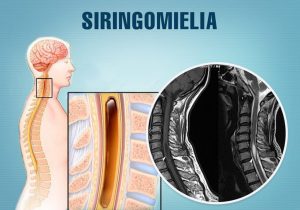[et_pb_section bb_built=”1″][et_pb_row][et_pb_column type=”4_4″][et_pb_text _builder_version=”3.13.1″]
It is a disease of the spinal cord characterized by the existence of cysts inside. Syringomyelia is the presence of a cyst or cavity inside the spinal cord.
Although medullary cysts are located mainly in the cervical region, they can enlarge and spread to other areas causing, among other symptoms characteristic of syringomyelia, pain, weakness, stiffness and loss of sensitivity for pain and temperature.
Depending on its cause, syringomyelia is divided into two groups:
- Idiopathic or congenital syringomyelia: of unknown cause.
- Secondary syringomyelia: syringomyelia appears as a consequence of acquired processes such as: Injuries, arachnoiditis (inflammation of the meninges, which are the membranes that surround the brain and spinal cord), intramedullary (spinal cord) tumors. Other causes of syringomyelia are resolved medullary abscesses (accumulations of pus located in the spinal cord) or tumors that compress the medulla from the outside (meningiomas).

Chronic pain is one of the main problems that patients with syringomyelia can present. For its treatment, analgesics (more or less potent depending on each specific case) or other drugs such as antidepressants, antiepileptic drugs or anesthetics with analgesic effect can be used.
Performing certain exercises can relieve pain and help maintain joint mobility. For this it is essential to follow the indications of specialists, who will be the ones who indicate to the patient what exercises he should do and how often.
Always take care of your health with a unique and efficient service. Visit Pharmamedic.
[/et_pb_text][/et_pb_column][/et_pb_row][/et_pb_section]






